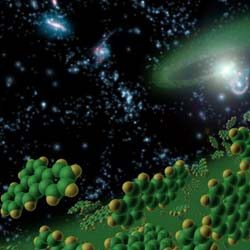Two highly complex organic molecules detected in space
 Berlin, April 21 : Scientists from the Max Planck Institute for Radio Astronomy in Bonn, Germany, Cornell University, USA, and the University of Cologne, Germany, have detected two of the most complex molecules yet discovered in interstellar space: ethyl formate and n-propyl cyanide.
Berlin, April 21 : Scientists from the Max Planck Institute for Radio Astronomy in Bonn, Germany, Cornell University, USA, and the University of Cologne, Germany, have detected two of the most complex molecules yet discovered in interstellar space: ethyl formate and n-propyl cyanide.
Their computational models of interstellar chemistry also indicate that yet larger organic molecules may be present - including the so-far elusive amino acids, which are essential for life.
The IRAM 30 m telescope in Spain was used to detect emission from molecules in the star-forming region Sagittarius B2, close to the center of our galaxy.
The two new molecules were detected in a hot, dense cloud of gas known as the "Large Molecule Heimat", which contains a luminous newly-formed star.
The new molecules ethyl formate (C_2 H_5 OCHO) and n-propyl cyanide (C_3 H_7 CN) represent two different classes of molecule - esters and alkyl cyanides - and they are the most complex of their kind yet detected in interstellar space.
Atoms and molecules emit radiation at very specific frequencies, which appear as characteristic "lines" in the electromagnetic spectrum of an astronomical source.
Recognizing the signature of a molecule in that spectrum is rather like identifying a human fingerprint.
"The difficulty in searching for complex molecules is that the best astronomical sources contain so many different molecules that their "fingerprints" overlap, and are difficult to disentangle," said Arnaud Belloche, scientist at the Max Planck Institute.
"Larger molecules are even more difficult to identify because their "fingerprints" are barely visible: their radiation is distributed over many more lines that are much weaker," said Holger Muller, researcher at the University of Cologne.
Out of 3700 spectral lines detected with the IRAM telescope, the team identified 36 lines belonging to the two new molecules.
The researchers then used a computational model to understand the chemical processes that allow these and other molecules to form in space.
The computational models suggest that the more complex molecules form section by section, using pre-formed building blocks that are provided by molecules, such as methanol, that are already present on the dust grains.
The computational models show that these sections, or "functional groups", can add together efficiently, building up a molecular "chain" in a series of short steps.
The two newly-discovered molecules seem to be produced in this way.
"There is no apparent limit to the size of molecules that can be formed by this process - so there's good reason to expect even more complex organic molecules to be there, if we can detect them," said Garrod. (ANI)